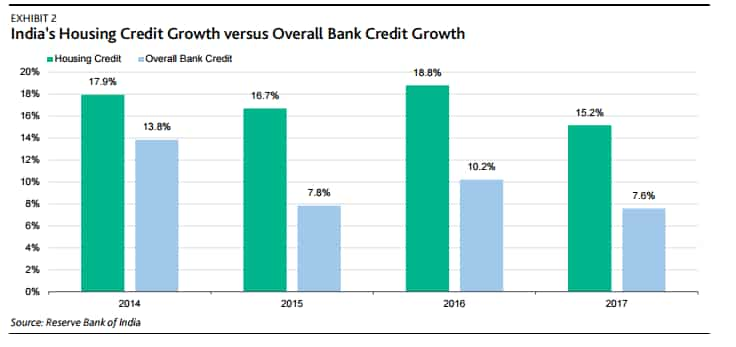RBI's reduction in risk weight of home loans credit negative for banks
RBI's action on risk weightage of home loans is seen as credit negative for Indian banks.

- Key Highlights:
- RBI reduces risk weight of home loans and provided 0.25% standard provision
- Bankers sees RBI's move on lowering risk weight positive for home loans
- Housing loans accounts 12% of the total credit disbursed by banks
The Reserve Bank of India (RBI) has lowered the risk weights and standard asset provisioning on housing loans in selective loan size category.
Here are the detail of RBI's move on home loan rates.

Chanda Kochhar, MD and CEO, ICICI Bank said, “It is also heartening that the RBI has again reiterated its focus on resolution of stressed assets which will help to strengthen the banking system and ensure that investments made are optimally utilized. The SLR cut and reduction in risk weights for housing loans are positive moves that will support bank liquidity and encourage growth in housing loans.”
Largest PSU lender State Bank of India's chairperson Arundhati Bhattacharya also said, “The decision to reduce the risk weights for home loans over Rs. 30 lakh category will release capital for the banking industry and is a positive move."
SBI following this move also trim down interest rates for its home loans above Rs 75 lakh. Revised interest rates will be 8.55% per annum for salaried women borrowers and 8.60% per annum for others.
Rajnish Kumar, MD, National Banking, SBI said, “Taking a cue from the recent RBI reduction in risk weightage on home loans, SBI is passing on the benefit to its customers by reducing its interest rates on home loan above Rs. 75 lakhs."
However, as per Alka Anbarasu and Jason Sin, analysts at Moody's Investors Service, the move is credit negative for Indian banking sector because lower capital requirements will weaken banks’ protection from the housing sector, which has grown rapidly in recent years, and will encourage greater lending.
"Over the next 12-18 months, we expect overall system credit growth to remain muted given banks’ weak balance sheets amid continued asset quality deterioration, " said analysts at Moody's.
At the end of March 2017, annual bank credit growth was 7.6%, down from 10.2% the previous year.
Further the duo at Moody's added, “This growth is occurring as non-bank finance companies increasingly target the home-loan segment, posing greater downside risk if there is a correction in property prices.”

Although lower risk weights would boost sluggish credit growth while limiting the effect on banks’ capital position, Moody's analysts believe competition for housing loans has significantly increased among banks and non-bank finance companies.
After carrying out discussion with banks, Moody's have confirmed that some areas of weaknesses have emerged in the luxury property segment following the Indian government’s demonetisation.
Get Latest Business News, Stock Market Updates and Videos; Check your tax outgo through Income Tax Calculator and save money through our Personal Finance coverage. Check Business Breaking News Live on Zee Business Twitter and Facebook. Subscribe on YouTube.
RECOMMENDED STORIES

Looking for short term investment ideas? Analysts suggest buying these 2 stocks for potential gain; check targets

Rs 3,500 Monthly SIP for 35 years vs Rs 35,000 Monthly SIP for 16 Years: Which can give you higher corpus in long term? See calculations
03:40 PM IST









 Attention SBI Customers: EMIs of home loan, personal loan go up as PSU bank hikes lending rate
Attention SBI Customers: EMIs of home loan, personal loan go up as PSU bank hikes lending rate  PMAY: Centre contemplates providing home loans to people without mandatory income proofs
PMAY: Centre contemplates providing home loans to people without mandatory income proofs Home Loan Calculator: How 10% extra down payment can help save Rs 20 lakh on Rs 75 lakh property; see calculations
Home Loan Calculator: How 10% extra down payment can help save Rs 20 lakh on Rs 75 lakh property; see calculations India's household debts surge on back of housing loans, rising trend of unsecured lending
India's household debts surge on back of housing loans, rising trend of unsecured lending How to find mortgage broker options that fit your budget
How to find mortgage broker options that fit your budget